This is the website of Abulsme Noibatno Itramne (also known as Sam Minter).
Posts here are rare these days. For current stuff, follow me on Mastodon
|
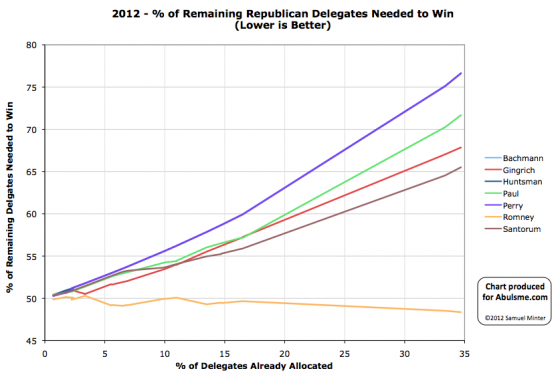
Chart from the Abulsme.com 2012 Republican Delegate Count Graphs page. When a candidate gets down to 0%, they have cinched the nomination. If they get up past 100%, they have been mathematically eliminated. Rather than the date on the x-axis, we show the “% of Delegates Already Allocated” as this better represents the progress through the race. Note that these numbers include estimates of the eventual results of multi-stage caucus processes which will be refined as the later stages occur.
So it appears that the last 34 delegates from Super Tuesday, a handful each from Georgia, Ohio and Tennessee, have been determined. 17 more to Romney, 8 more to Gingrich and 5 more to Santorum. But wait, that is only 30! Well, according to Green Papers, 4 of the 63 delegates that were up for grabs in Ohio end up officially “Uncommitted”, which (I think) means we won’t actually know which way they may go until we know which actual human beings end up being those delegates and those people say publicly who they plan on supporting (which they may or may not actually do before the convention).
All in all, today’s results are once again a win for Romney. He got 56.7% of today’s delegates, which was way more than the 48.5% he needed to continue to move closer to the nomination rather than further way. His “% of remaining needed to win” drops now to 48.4%. For the other candidates, the effect on the other side is more dramatic. Santorum is still in 2nd place, but his “% of remaining needed to win” moves up from 64.5% to 65.5%. Romney may not yet be rapidly moving toward cinching the nomination, but the non-Romneys are rapidly moving toward being mathematically eliminated.
Looking at the non-Romney’s for a minute, the next few states are expected to favor them. Perhaps Santorum will win some. Perhaps Gingrich will win some. But to actually be on a pace to win, Santorum has to not just win a state, but win by a huge margin, getting more than 65.5% of the delegates. For Gingrich it is even worse, he would need to win getting 67.8% of the delegates. (For completeness, Paul would need to get more than 71.7%.)
Even with Romney expected to not be strong in these states, with four candidates in the race, you don’t expect anybody to be able to pull that kind of level except in winner take all (or winner take almost-all) states. Of the next few coming up… in Kansas, Guam, Northern Marianas, Virgin Islands, Alabama, Mississippi, Hawaii and American Samoa there are as usual complicated delegate rules (and the territories might only select uncommitted delegates), but none of them are straight up winner takes all. (Some allow for certain situations that could lead there though.) Bottom line, 65.5% (or more) is a pretty big ask and seems unlikely.
Which means that even if Santorum or Gingrich win some states (as expected) in terms of delegates they will almost certainly still both be heading closer to mathematical elimination rather than closer to the nomination. The big thing to look at will once again be looking at how well the non-Romney’s collectively block Romney from getting the 48.4% of the delegates he needs to be closing in on the nomination himself. With strong performance by the non-Romney’s in the next few contests, they may well be able to achieve this, even if they don’t actually help themselves individually.
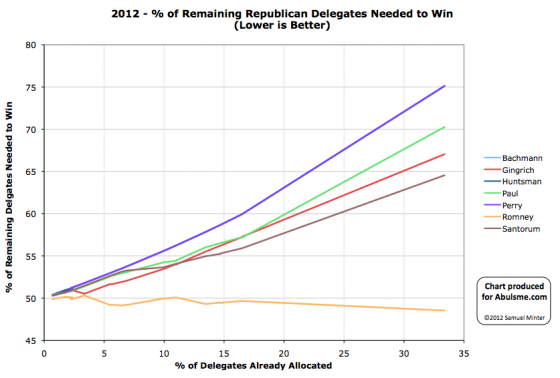
Chart from the Abulsme.com 2012 Republican Delegate Count Graphs page. When a candidate gets down to 0%, they have cinched the nomination. If they get up past 100%, they have been mathematically eliminated. Rather than the date on the x-axis, we show the “% of Delegates Already Allocated” as this better represents the progress through the race. Note that these numbers include estimates of the eventual results of multi-stage caucus processes which will be refined as the later stages occur.
So, Super Tuesday happened. As of this update, Green Papers has “called” 385 of the 419 delegates available from the Super Tuesday contests. There are 34 delegates that haven’t been determined yet that will result in updates later, but of the ones we do know, the estimates for Super Tuesday contests are: Romney 208, Santorum 84, Gingrich 72, Paul 21. Romney also picked up a Superdelegate, bringing the total for the day to Romney 209, Santorum 84, Gingrich 72, Paul 21.
Compared to the Sabato Crystal Ball projections which we used to game out Super Tuesday over the weekend, Romney performed better than expectations, as did Gingrich. Santorum and Paul underperformed compared to those predictions. In any case, where does this put us…
Bottom line, Romney is the big winner today, and this may be the start of him actually pulling away and heading toward the nomination, but he is still not out of the woods in terms of the danger of being blocked from 1144. Lets look at the details.
The situation for Santorum, Gingrich and Paul is essentially what I mapped out in the gaming Super Tuesday post. To paraphrase what I said there, it is now absolutely undeniably clear (although the trend was obvious even before today) that none of these three guys are on a path to the nomination. Of the three, Santorum is doing the best, but with today’s numbers, to be on a path to win, he would need to now get 64.5% of the remaining delegates, compared to the 21.1% he has gotten so far. For this to even come into the realm of possibility, Gingrich and Paul would both have to stop getting delegates, Santorum would have to pick up all of their support, AND something would need to happen to cause support for Romney to plummet. This is a very unlikely sequence of events. It isn’t going to happen.
Oh, I guess I should also note that Gingrich pulled back ahead of Paul for 3rd place.
The remaining question is: “Are the non-Romney’s collectively still in a position to potentially block Romney from getting to 1144?” If after today, Romney was under 50% of the total delegates, and his “% of remaining needed to win” was heading upward or flat, this is a possibility that would be looking like it was still very much in play. But Romney exceeded the 49.7% of delegates he needed in order to be on track toward 1144, and did it by a decent margin. Of the delegates in today’s total, he picked up 209 of 386, or 54.1%. This reduced his “% of remaining needed to win” from 49.7% to 48.5%. That means to block, the non-Romney’s collectively need to be getting 51.5% of the delegates, compared to the 46.9% they have managed so far. So they have to do better than they have been so far, and by a non-trivial margin. And they have do do this even though it is obvious none of them can win outright. It has to be about stopping Romney.
Now, the rest of March has a bunch of states that are supposed to be relatively good for the non-Romneys. So the non-Romney’s managing to get 51.5% in the next few state is very much within the realm of possibility. After that we hit more Romney friendly states in April. The thing to watch for in the upcoming states is not who wins the popular vote, or even the delegate count. The question will be: “Is Romney continuing to get enough delegates to avoid being blocked?” Right now, that magic number is 48.2%. As long as he is getting 48.2% of the delegates (or more) then he is marching his way toward the nomination. If he gets less than that, then blocking will remain possible a little bit longer. If the rest of March really is friendly to the non-Romneys, we may see that Romney’s “% needed to win” starts heading back up a bit before Romney hits friendly states again and starts fully pulling away. As long as we see that happening, blocking Romney is still a possibility. And indeed, if Romney is damaged by the contests in March and his April states start looking not so good after all, then blocking starts looking more real again.
But Romney’s “% of remaining needed to win” is the smallest it has been so far, and none of the other candidates have realistic shots at winning, only a shot at blocking that relies on them continuing to win delegates even though it is obvious they can’t win, so Romney is in a pretty good position right now. Watch that line though. Until it starts heading downward decisively, Romney hasn’t got it wrapped up just yet.
So what is next? Well, first, the last 34 delegates from Super Tuesday (they are from Georgia, Ohio and Tennessee). Then on Sunday we have Kansas (40), Guam (9), Northern Marianas (9), Virgin Islands (9). Then Tuesday we have Alabama (50), Mississippi (40), Hawaii (20), American Samoa (9). And then it goes on and on…
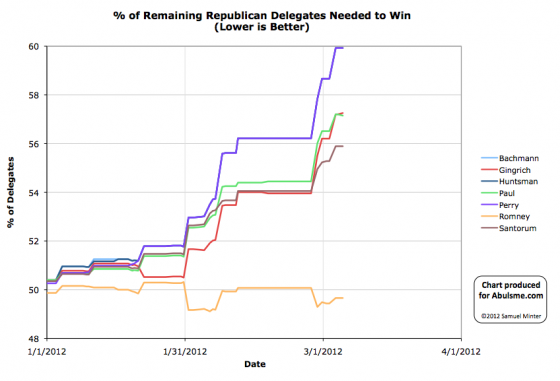
Chart from the Abulsme.com 2012 Republican Delegate Count Graphs page. When a candidate gets down to 0%, they have cinched the nomination. If they get up past 100%, they have been mathematically eliminated. Note that these numbers include estimates of the eventual results of multi-stage caucus processes which will be refined as the later stages occur.
The delegate count estimate in Maine is apparently a little jittery. On February 12th I posted the initial results as Paul 8, Romney 8, Santorum 4, Gingrich 1. On February 18th Green Papers updates this to Romney 8, Paul 7, Santorum 4, Gingrich 2. Today this seems to have gotten updated back to Paul 8, Romney 8, Santorum 4, Gingrich 1. So this means for the day Paul gains a delegate and Gingrich loses a delegate. At this point though, one delegate alone doesn’t make a significant difference in the overall picture.
According to our Soft Green Papers plus DCW Superdelegate count though, this means Ron Paul actually pulls ahead of Newt Gingrich into 3rd place in the delegate count by a two delegate margin. So I guess there is that.
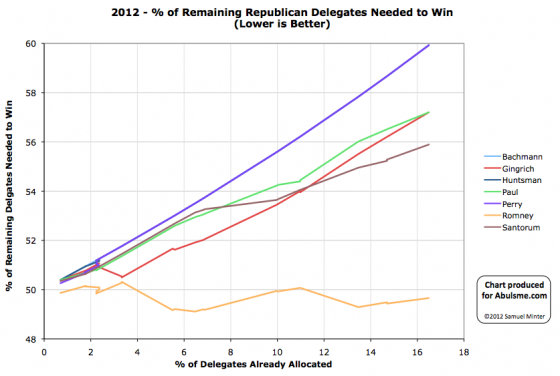
Chart from the Abulsme.com 2012 Republican Delegate Count Graphs page. When a candidate gets down to 0%, they have cinched the nomination. If they get up past 100%, they have been mathematically eliminated. Rather than the date on the x-axis, we show the “% of Delegates Already Allocated” as this better represents the progress through the race. Note that these numbers include estimates of the eventual results of multi-stage caucus processes which will be refined as the later stages occur.
So, today’s update includes the preliminary estimates from the Washington caucuses. As always, is important to note that no actual delegates were allocated at this point. That will happen at later stages of the process. Our graphs reflect Green Paper‘s “soft count” estimate, which will change over time as the later stages of the process happen. By those estimates, the results were Romney 16, Paul 10, Santorum 10, Gingrich 4. Santorum also picked up a super delegate since yesterday’s update. So for the day: Romney 16, Santorum 11, Paul 10, Gingrich 4.
Bottom line though, we have yet another day where EVERYBODY LOSES. Of course the narrative is all about how Romney has now “won” several in a row, and this gives him momentum going into Super Tuesday. And of course that is a very real effect. “Winning” and the media spin around it have a huge effect. People don’t just vote for their favorite candidate, they tend to want to vote for someone that can win. So things may change in future contests.
But as of right now, Romney did the best of the night, but he needed to get 49.4% of the delegates to be “on pace” to get to 1144. He actually got 16/41, or only 39.0%. So the percentage of remaining delegates he needs to get to win actually increases from 49.4% up to 49.7%. This isn’t a big move, but it is a move in the wrong direction. To be wrapping this up, Romney needs to be winning by numbers that drive this metric down. So far, he continues to hover in the range where if he continues as he has been, he will eventually win, but if he starts to do even slightly worse, he can be blocked.
For the non-Romneys, their path to the nomination continues to get more and more unlikely. Santorum is still in second place. He now needs 55.9% of the remaining delegates to catch up and win. This would be a remarkable change from the 20.4% of delegates he has managed so far. The more realistic goal for the non-Romneys at this point continues to be that they collectively get enough delegates to block Romney, not that any of them actually collect enough to win themselves. (Having said that, one of these guys catching up is not yet actually impossible if something major happens, it is just getting increasingly likely.)
I’ll also note that according to our estimates (combining the Soft Green Papers count and the DCW super delegate count) Ron Paul has now caught up and tied with Newt Gingrich for 3rd in the delegate count.
And now we have Super Tuesday. Although not as big as 2008, we’ll still have a large number of delegates awarded. The main thing to look out for: Does Romney’s “% of remaining needed to win” actually start to drop? If not, the possibility of him not getting to 1144 gets a lot more serious.
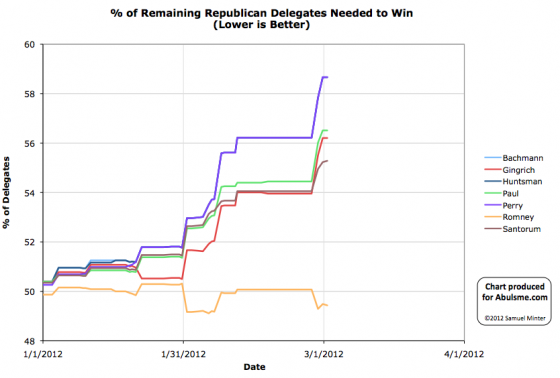
Chart from the Abulsme.com 2012 Republican Delegate Count Graphs page. When a candidate gets down to 0%, they have cinched the nomination. If they get up past 100%, they have been mathematically eliminated. Note that these numbers include estimates of the eventual results of multi-stage caucus processes which will be refined as the later stages occur.
So, everybody expected that 2 of Michigan’s delegates would be allocated proportionately, which meant that unless it was a complete blowout, you’d get one delegate each for the top two candidates statewide. But the Michigan GOP gave both delegates to Romney when they released the official results. They say that the proportional thing was a misunderstanding due to an error in an earlier memo and it was always going to be that way. The Santorum camp is calling shenanigans. More on this here and here. In any case, the result for the day is that Romney gains a delegate and Santorum loses one. It is just one delegate though, so the overall picture remains essentially the same.
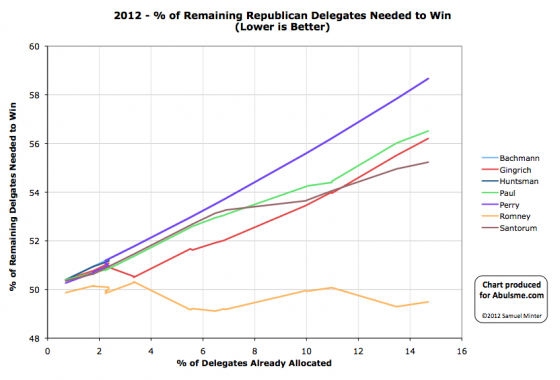
Chart from the Abulsme.com 2012 Republican Delegate Count Graphs page. When a candidate gets down to 0%, they have cinched the nomination. If they get up past 100%, they have been mathematically eliminated. Rather than the date on the x-axis, we show the “% of Delegates Already Allocated” as this better represents the progress through the race. Note that these numbers include estimates of the eventual results of multi-stage caucus processes which will be refined as the later stages occur.
So, first of all, that final congressional district in Michigan went for Santorum, so 2 more delegates for Santorum, making the final Michigan numbers 15 for Romney and 15 for Santorum, which was an exact match for my Scenario 2 in the post gaming out Arizona and Michigan.
Secondly, we have Wyoming. It is very important with Wyoming (as with similar caucuses previously) to point out that no national delegates were actually allocated in Wyoming yet. There was a straw poll, which doesn’t matter, and local delegates were selected for the next stage in the caucus process that will eventually select delegates to the national conventions. Ideally, each local delegate who was selected would be polled for their presidential preferences, and that would be used to predict results at the next level, etc. But that would be a ton of work, and nobody is doing that. Our source for these things, The Green Papers is doing the estimating by using the straw poll numbers for all candidates who got more than 5%. These estimates WILL change (perhaps significantly!) when the later caucus stages happen, but for now that is what we have. Green Papers estimates Wyoming as: Romney 10, Santorum 8, Paul 6, Gingrich 2.
And so when we pump this into the grinder and look at the “% of remaining needed to win” charts that I argue are the best way to see what is really happening… we find out… EVERYBODY LOSES. All four candidates in the race got delegates since my last update yesterday, but none of them got the delegates at the rate they would need to in order to get to 1144. Romney of course came closest. He got 10 out of 28 delegates today, or 35.7% of the delegates. But he needed to get 49.3% of the delegates (at least 14 of today’s 28) to actually be on pace to get to 1144.
Romney is still way ahead though. Right now he needs 49.5% of the remaining delegates to win. Santorum is in second needing 55.2% of the remaining delegates to win.
We are still fundamentally in a state where if Romney continues the way he has been, he will get to 1144, but very very late in the process… but with the possibility of the non-Romney’s blocking him still real. The non-Romney’s only have to do a little better than they have been to block Romney. One of the non-Romney’s actually catching up and winning gets to be an increasingly remote possibility as we move on though. Still not impossible. Just getting very hard. You would basically need consolidation around one non-Romney at the same time that Romney himself lost a significant amount of support.
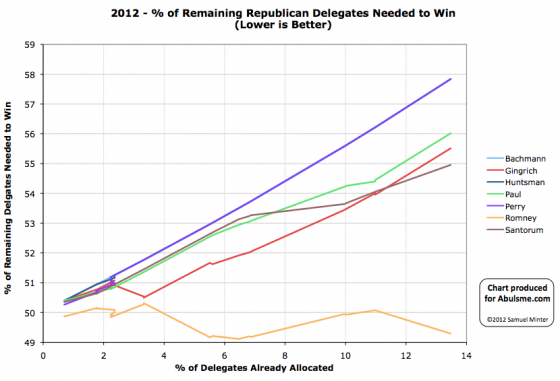
Chart from the Abulsme.com 2012 Republican Delegate Count Graphs page. When a candidate gets down to 0%, they have cinched the nomination. If they get up past 100%, they have been mathematically eliminated.
The chart above is now the chart using the “% of delegates already allocated” as the x-axis rather than the date, because I think it more clearly shows what is actually going on at this point.
Romney picks up all 29 delegates from Arizona. As of this update the best estimates at The Green Papers gives Romney 15 delegates from Michigan, Santorum 13, and 2 delegates still too close to call. Those of you who read my Gaming Out Arizona and Michigan post will recognize Scenario 2, which at the time I said was the most likely result, and indeed, that is what happened. If the last outstanding congressional district ends up going for Santorum, then it will actually match Scenario 2 exactly. Regardless though, the general outlines of Scenario 2 are met, and I’ll just quote my analysis from that earlier post:
Romney is still the only winner here. It is clearly not as big a win [as if he had won nearly all of Michigan’s delegates through a more geographically even win], but Romney still makes his “% of remaining delegates needed to win” go DOWN, and go down to under 50%. Santorum, despite getting some delegates, is still in a worse position than when he started the night. Before he needed 54.1% of the remaining delegates to catch up and win the nomination, now he needs 54.9% [actually 55.0% pending disposition of those last 2 delegates]. Santorum does pull ahead of Gingrich though, and put himself clearly into second place. But the three non-Romney’s in this situation are still all heading upward (toward being mathematically eliminated), none of them has started to actually move down toward catching up and winning. Romney in this situation does improve a bit here, but also still isn’t breaking out downward yet. He is still hovering in the zone where his opponents (collectively) only have to do a little bit better to block him from getting the nomination. Note that they do have to do better though. Paul, Gingrich and Santorum could keep getting delegates at the same rate, and Romney would still get the nomination, it would just take awhile.
Attention now moves to first Wyoming and Washington (although they are not getting much attention) and then of course Super Tuesday. Super Tuesday is not as super as it was in 2008, but there are still a big chunk of delegates at stake, and after it is over, we should have a better view of what the rest of the race looks like, and specifically if Romney is able to break out and start closing on 1144, or if the non-Romney’s still have a real shot at blocking him from getting there. (Let alone actually catching up and winning, which is a much further stretch.)
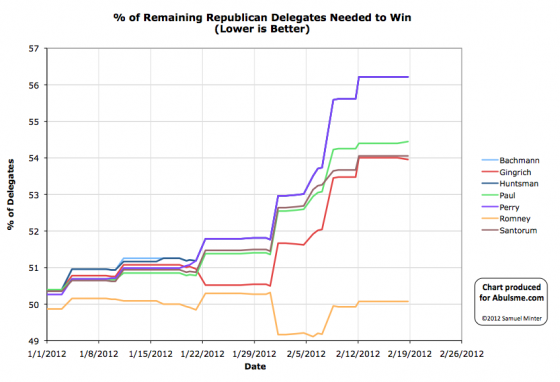
Chart from the Abulsme.com 2012 Republican Delegate Count Graphs page. When a candidate gets down to 0%, they have cinched the nomination. If they get up past 100%, they have been mathematically eliminated.
A small change today. Maine revised its preference poll numbers to add some precincts whose results got lost in a spam folder (really). The result from this is that the delegate estimates give one less delegate to Paul, and one more to Gingrich. So Gingrich wins the day today.
But Maine’s results will change again. First, there are still more precincts who haven’t done their votes yet (or are doing them today). So there may well be more straw poll Maine updates to come.
More importantly though, these are only estimates based on the straw polls, in fact, no delegates have been selected at all yet. In fact, delegates to the state convention were selected, who in turn will select delegates to the national convention. That won’t happen until MAY. Estimates of what will happen in May really should be based on asking each of the delegates to the next level of the process who they intend to support. But nobody seems to be doing that sort of things, so instead we (well, Green Papers) base estimates on the straw polls. But the real results may be very different. You may have someone like Paul out organizing and getting an outsized number of delegates compared to the star poll (the Paul campaign claims they are on track to do this), or, you may have the nominee being a done deal by May, and get all delegates allocated to the obvious winner, regardless of what happened in February.
Anyway, with the best estimate we have as of when I pulled the numbers a couple hours ago, today Gingrich gains a delegate and Paul loses one.
Edit 2012 Feb 18 23:10 – Minor wording change
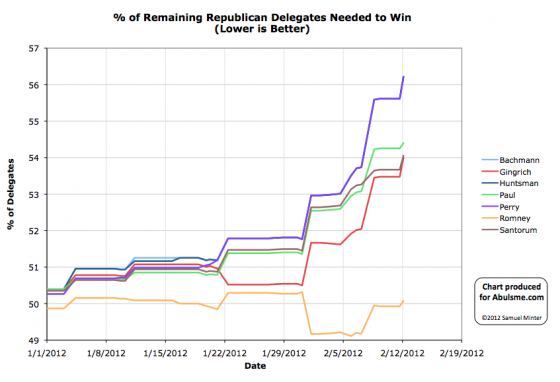
Chart from the Abulsme.com 2012 Republican Delegate Count Graphs page. When a candidate gets down to 0%, they have cinched the nomination. If they get up past 100%, they have been mathematically eliminated.
So. Maine. A few things to say before looking at any numbers here. Maine is another of those states where no actual delegates were designated by the initial caucuses there. Instead, two things happened. First, there was a straw poll. Second, there was the elections to the delegates of the next round. The second thing is actually related to who eventually gets delegates when all is said and done months from now. The first does not. At all. But it is what is reported because it is an easy to understand result. Also, it should be said that some precincts in Maine haven’t even had their caucuses yet. They don’t get to participate in the straw poll (because it is over) but they will get to vote on delegates and such. The “real” result tonight, as in many of the caucus states, is that no delegates at all have been allocated yet.
For this site, we use estimates from The Green Papers for delegates. These assume that the eventual delegate allocation will be proportional to the straw poll results, at least at first approximation. When later rounds of the delegate selection process happen, the numbers will get revised and may be quite different. As an example, the Ron Paul campaign is saying that they think in the end they will actually get the most delegates from Iowa, Minnesota and Colorado because they had their people stay around after the straw polls and actually run to be delegates to the later stages while the other campaigns for the most part ignored this. We shall see how that plays out. In the mean time, while one can look at only completely determined delegates like DCW does in their primary count, but we’ll use the projected eventual delegates from caucus states until better numbers are available later in the process…
Anyway, now on to the main event. Since the last update, we had the preliminary Maine results (estimated as described above), and Ron Paul gained one superdelegate. So for the day, Paul gains 9 delegates, Romney 8, Santorum 4 and Gingrich 1. So Paul wins the day, right? Or maybe like most people saying, it is a win for Romney since he got the most actual votes in the straw poll?
Wrong. The right answer is that after today EVERYBODY is further away from the nomination than they were yesterday. (Paul just lost the least ground.) Nobody got a high enough percentage of the delegates from today to be on track for getting to 1144 delegates before the convention. The delegate take is continuing to be split in such a way that nobody is taking a majority of the delegates.
In fact, with these results, Romney slips below 50% of the delegates allocated so far for the first time since his big delegate win from the winner take all contest in Florida. Prior to today, if he just continued getting delegates at the same percentage he had been so far, he would win the nomination. Since he is now below 50% again, that means he has to actually improve his performance above his historical levels (slightly) to get to 1144.
Of course we have another winner take all state (Arizona) coming up soon, and that may help Romney’s situation considerably if he wins there (as the current polls indicate is likely).
It is also worth pointing out though that even though Romney’s real position in the race (in terms of % of remaining delegates needed to win) was hurt today like everybody’s else’s… the gap between him and his closest competition (still Gingrich, despite Santorum closing rapidly) continues to grow. Romney now needs 50.1% of the remaining delegates to get to 1144. This is just slightly better than the 49.8% he has gotten so far. By comparison, Gingrich now needs 54.0% to catch up and actually get to 1144. This would be a huge change from the 17.9% he has managed so far.
As long as Romney is hovering around 50% of the delegates rather than consolidating and heading rapidly north of that number, we’re going to be hearing the talk about him not managing to get to 1144 and thus potentially ushering in the first brokered convention in decades. While this is an exciting possibility, the road there is still narrow, and Romney is still very much in shooting distance of an outright win.
If however as we hit the next few contents, we see his “% of remaining delegates needed to win” number staying above 50% and actually start to trend consistently UPWARD rather than flat or down… then that talk starts to be more of a real possibility.
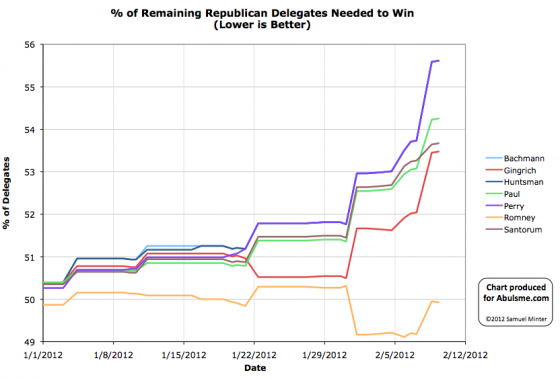
Chart from the Abulsme.com 2012 Republican Delegate Count Graphs page. When a candidate gets down to 0%, they have cinched the nomination. If they get up past 100%, they have been mathematically eliminated.
Romney picks up another superdelegate. This of course slightly improves his sitaution and slightly degrades everybody else’s.
Currently Romney needs 49.9% of the remaining delegates to win. His closest competition, Gingrich, needs 53.5% of the remaining delegates to be able to catch up and win. Santorum needs 53.7%. And finally Paul is furthest behind of the candidates still in the race, needing 54.3% of the remaining delegates to catch up and win.
|
|









